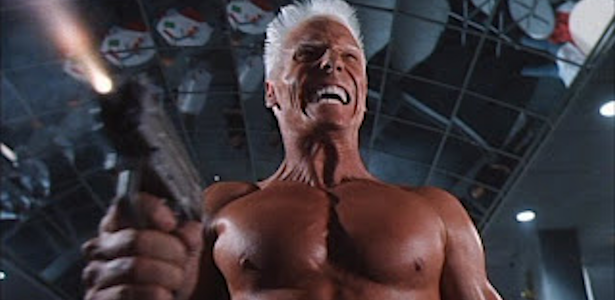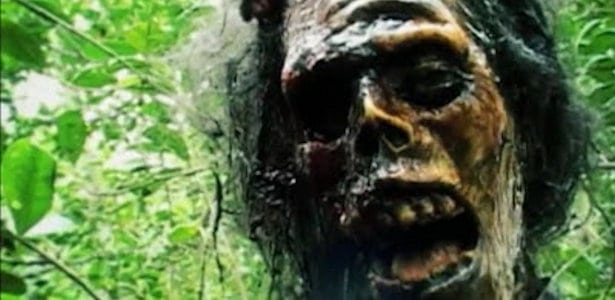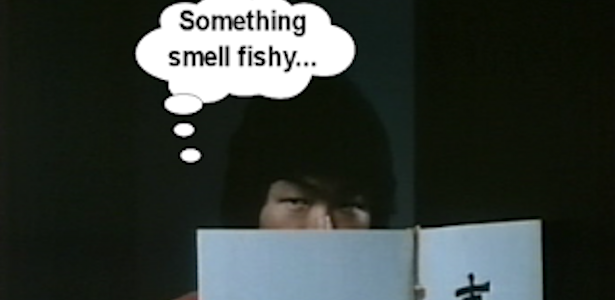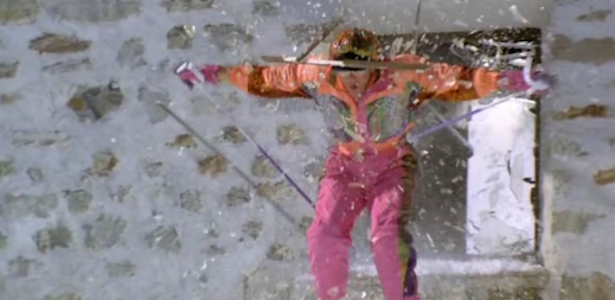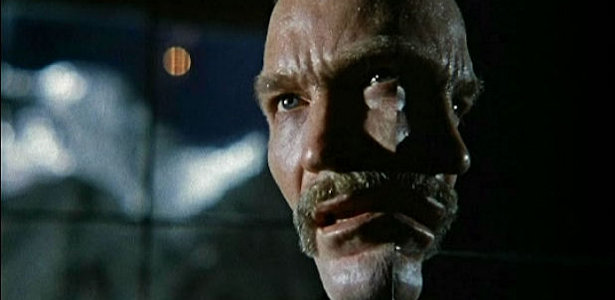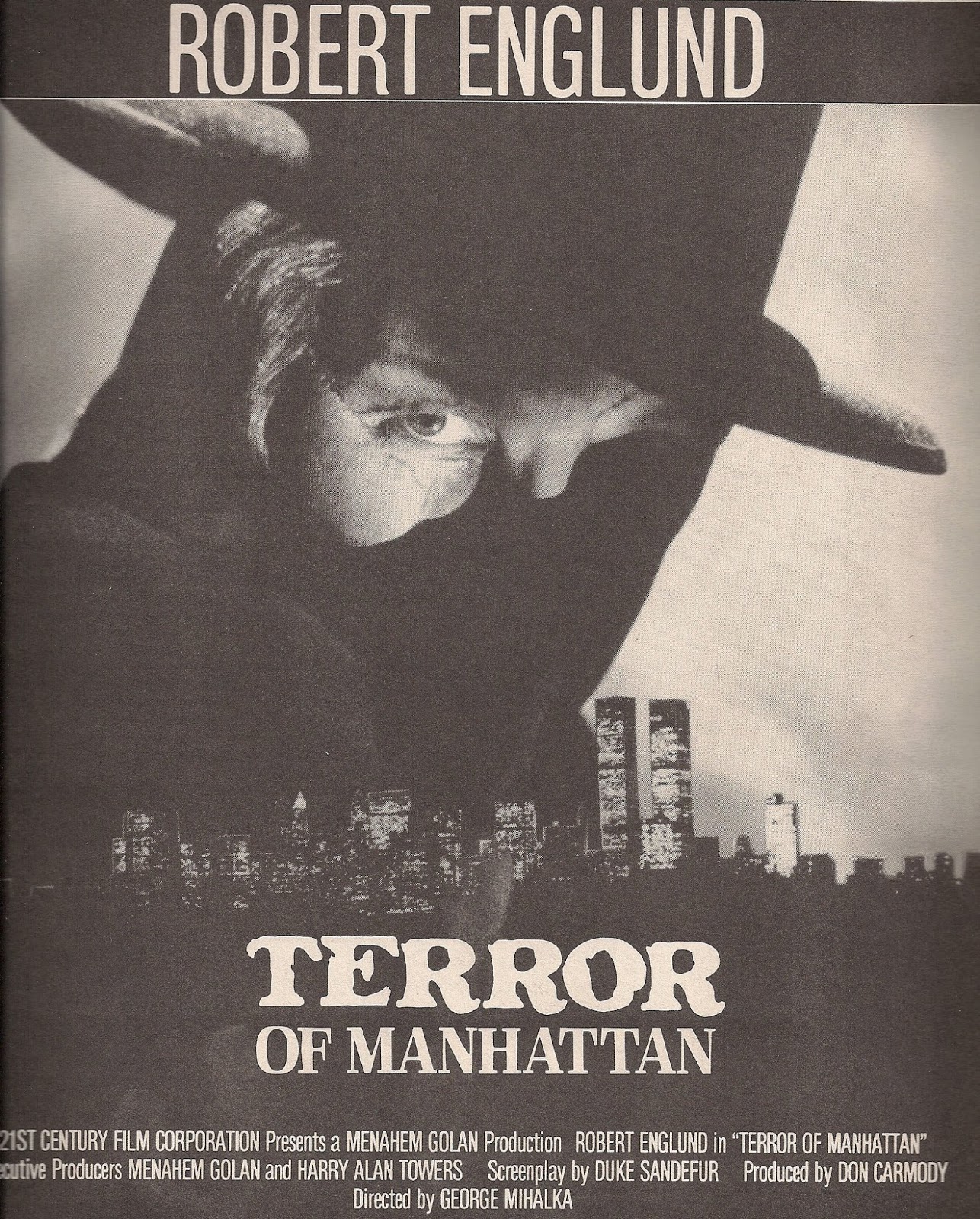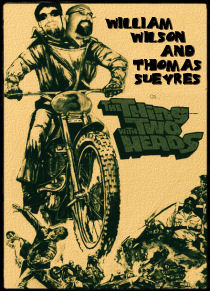Horror as a genre tends to be borderless. Being human makes a lot of horror's themes relatable by nearly everyone, everywhere regardless of where they live. Because of this, there really is no need to set the location in an actual place. You can make it Anytown, USA and no one will really notice. However, when you set the location, you get all of the area's history and superstitions to draw on. In the US, there are locations that naturally lend themselves to the genre. We have Massachusetts' witchburnings, Pennsylvania's Arkham Asylum, and New Hampshire made famous by Sutter Cane. Oh yeah, and there's Maine, the setting for novels by some weird lookin' dude who never amounted to much. Then there is Louisiana, a state that is arguably the richest in superstitious folklore, creepy scenery and dark history. So why isn't it used more? It's a question that will probably never be answered, but one that should be asked more often.
In "northern" Louisiana a campground is the site of a horrific massacre. Most horrific is the acting of the victims of clawed green hands. The police have written it off as a wolf attack, but local journalist Clint Harrison (Mark LaCour) knows damn well that there haven't been any wolf sightings in the area for over 150 years. His boss Mr. Daniels (Eddie Moore) tells him to forget all that, and that his boss wants Clint to investigate an abandoned house. Apparently 150 years ago the area was the site of a string of serial killings that went unreported. So basically, the hell with the massacre that happened last night, let's get on the murders that supposedly happened a century and a half ago that nobody ever talked about. The deal is that Clint and a couple of volunteers from the printing department, are to spend a night in the house as a fluff piece. To this effect the guys are given a video camera and a swift kick in the ass, as for some reason Mr. Daniels is irate over this idea. After telling Clint that there is nothing to it, he tells Clint that he is crazy for taking the assignment and that he is "totally opposed to it." Typical bad middle management, delivering conflicting messages to subordinates.
 After driving out into the sticks and hiking three miles up to the house, the other guys start getting scared, even though one is packing enough heat to make Dirty Harry self-conscious. Clint recounts some of the history of the Danson (amusingly pronounced "dancin'") house which was the site of horrible murders that only happened during thunder storms. Amazingly in spite of being abandoned for 100 years, there isn't a speck of dust and everything is in pretty nice shape. The guys set up their video camera and take watch. Of course Clint is woken up by a specter in the window during a thunderstorm only to find the others gone and the camera smashed to pieces.
After driving out into the sticks and hiking three miles up to the house, the other guys start getting scared, even though one is packing enough heat to make Dirty Harry self-conscious. Clint recounts some of the history of the Danson (amusingly pronounced "dancin'") house which was the site of horrible murders that only happened during thunder storms. Amazingly in spite of being abandoned for 100 years, there isn't a speck of dust and everything is in pretty nice shape. The guys set up their video camera and take watch. Of course Clint is woken up by a specter in the window during a thunderstorm only to find the others gone and the camera smashed to pieces.
After returning to the office, Mr. Daniels gives him the third degree accusing him of not staying in the house at all and then accusing him of murdering the other two guys! There are no bodies and no motive, but he's going to fry for it (presumably in a crispy cornmeal coating). He then says "I'm just trying to help." As if that wasn't schizophrenic enough, Mr. Daniels gives Clint three weeks paid leave to get his head together, but definitely not to work on the story.
 Of course you know what that means. Clint decides that there is a connection between the house and the campsite massacre, but the hard part is actually proving it. After hooking up with another couple of expenda - err, I mean dependable volunteers, the guys gradually uncover the sinister secret of the house and a network of tunnels underneath it. Amusingly, the way they discover the tunnels is because they figured they would check the area of the campsite massacre for clues that the police overlooked. How to they do this? By digging up patches of soil with shovels. Hey, they didn't know about forensic science! "CSI" hadn't been broadcast yet. Also, when one of the schmucks gets killed because during a thunderstorm they decide to hang out in the camper of a murdered couple (who apparently were tidy enough not to spill blood anywhere), Clint flips out and wants to bury his body because he thinks that the police are already suspicious of him for the last two disappearances! Sure, nothing suspicious at all about a missing person in a shallow grave on a crime scene. Nobody will ever know. I think Clint's mamma must have been drinkin' something funny when she was pregnant.
Of course you know what that means. Clint decides that there is a connection between the house and the campsite massacre, but the hard part is actually proving it. After hooking up with another couple of expenda - err, I mean dependable volunteers, the guys gradually uncover the sinister secret of the house and a network of tunnels underneath it. Amusingly, the way they discover the tunnels is because they figured they would check the area of the campsite massacre for clues that the police overlooked. How to they do this? By digging up patches of soil with shovels. Hey, they didn't know about forensic science! "CSI" hadn't been broadcast yet. Also, when one of the schmucks gets killed because during a thunderstorm they decide to hang out in the camper of a murdered couple (who apparently were tidy enough not to spill blood anywhere), Clint flips out and wants to bury his body because he thinks that the police are already suspicious of him for the last two disappearances! Sure, nothing suspicious at all about a missing person in a shallow grave on a crime scene. Nobody will ever know. I think Clint's mamma must have been drinkin' something funny when she was pregnant.
 As, no doubt, you can tell this is a rip-off of Lovecraft's "The Lurking Fear". I say "rip-off" because there is no credit given to Lovecraft or his story in the credits. Though strangely there is no credited writer at all, so perhaps the writing credits were left off by accident. Yeah, that's it, blame the lab. Interestingly transplanted from the Catskills of upper New York to the unnamed Northern Louisiana woods, but this is a rank amateur production, make no mistake. The writing and acting is on par with countless other shot on video horror flicks from the late '80s, except for one very discriminating factor: it was shot on film. As far as I'm concerned, going through the laborious and expensive process of shooting with film is what separates the wheat from the chaff. Anybody can grab a video camera and screw around with their friends and call it a movie (for some reason Jon McBride comes to mind). Here producer-director David McCormick takes a break from his usual gig as an editor and gives us his one and only film. I totally respect the fact that not only is his singular, personally financed project shot on film, but it is an adaptation of a Lovecraft story. Plus it stays true to the Louisiana location as everybody in the movie, and I do mean everyone, is strapped an loaded.
As, no doubt, you can tell this is a rip-off of Lovecraft's "The Lurking Fear". I say "rip-off" because there is no credit given to Lovecraft or his story in the credits. Though strangely there is no credited writer at all, so perhaps the writing credits were left off by accident. Yeah, that's it, blame the lab. Interestingly transplanted from the Catskills of upper New York to the unnamed Northern Louisiana woods, but this is a rank amateur production, make no mistake. The writing and acting is on par with countless other shot on video horror flicks from the late '80s, except for one very discriminating factor: it was shot on film. As far as I'm concerned, going through the laborious and expensive process of shooting with film is what separates the wheat from the chaff. Anybody can grab a video camera and screw around with their friends and call it a movie (for some reason Jon McBride comes to mind). Here producer-director David McCormick takes a break from his usual gig as an editor and gives us his one and only film. I totally respect the fact that not only is his singular, personally financed project shot on film, but it is an adaptation of a Lovecraft story. Plus it stays true to the Louisiana location as everybody in the movie, and I do mean everyone, is strapped an loaded.
Granted it's not the best Lovecraft adaptation you'll ever see, but the reckless enthusiasm and genuine sweat equity make it an enjoyable one in my eyes.
In "northern" Louisiana a campground is the site of a horrific massacre. Most horrific is the acting of the victims of clawed green hands. The police have written it off as a wolf attack, but local journalist Clint Harrison (Mark LaCour) knows damn well that there haven't been any wolf sightings in the area for over 150 years. His boss Mr. Daniels (Eddie Moore) tells him to forget all that, and that his boss wants Clint to investigate an abandoned house. Apparently 150 years ago the area was the site of a string of serial killings that went unreported. So basically, the hell with the massacre that happened last night, let's get on the murders that supposedly happened a century and a half ago that nobody ever talked about. The deal is that Clint and a couple of volunteers from the printing department, are to spend a night in the house as a fluff piece. To this effect the guys are given a video camera and a swift kick in the ass, as for some reason Mr. Daniels is irate over this idea. After telling Clint that there is nothing to it, he tells Clint that he is crazy for taking the assignment and that he is "totally opposed to it." Typical bad middle management, delivering conflicting messages to subordinates.
 After driving out into the sticks and hiking three miles up to the house, the other guys start getting scared, even though one is packing enough heat to make Dirty Harry self-conscious. Clint recounts some of the history of the Danson (amusingly pronounced "dancin'") house which was the site of horrible murders that only happened during thunder storms. Amazingly in spite of being abandoned for 100 years, there isn't a speck of dust and everything is in pretty nice shape. The guys set up their video camera and take watch. Of course Clint is woken up by a specter in the window during a thunderstorm only to find the others gone and the camera smashed to pieces.
After driving out into the sticks and hiking three miles up to the house, the other guys start getting scared, even though one is packing enough heat to make Dirty Harry self-conscious. Clint recounts some of the history of the Danson (amusingly pronounced "dancin'") house which was the site of horrible murders that only happened during thunder storms. Amazingly in spite of being abandoned for 100 years, there isn't a speck of dust and everything is in pretty nice shape. The guys set up their video camera and take watch. Of course Clint is woken up by a specter in the window during a thunderstorm only to find the others gone and the camera smashed to pieces.After returning to the office, Mr. Daniels gives him the third degree accusing him of not staying in the house at all and then accusing him of murdering the other two guys! There are no bodies and no motive, but he's going to fry for it (presumably in a crispy cornmeal coating). He then says "I'm just trying to help." As if that wasn't schizophrenic enough, Mr. Daniels gives Clint three weeks paid leave to get his head together, but definitely not to work on the story.
 Of course you know what that means. Clint decides that there is a connection between the house and the campsite massacre, but the hard part is actually proving it. After hooking up with another couple of expenda - err, I mean dependable volunteers, the guys gradually uncover the sinister secret of the house and a network of tunnels underneath it. Amusingly, the way they discover the tunnels is because they figured they would check the area of the campsite massacre for clues that the police overlooked. How to they do this? By digging up patches of soil with shovels. Hey, they didn't know about forensic science! "CSI" hadn't been broadcast yet. Also, when one of the schmucks gets killed because during a thunderstorm they decide to hang out in the camper of a murdered couple (who apparently were tidy enough not to spill blood anywhere), Clint flips out and wants to bury his body because he thinks that the police are already suspicious of him for the last two disappearances! Sure, nothing suspicious at all about a missing person in a shallow grave on a crime scene. Nobody will ever know. I think Clint's mamma must have been drinkin' something funny when she was pregnant.
Of course you know what that means. Clint decides that there is a connection between the house and the campsite massacre, but the hard part is actually proving it. After hooking up with another couple of expenda - err, I mean dependable volunteers, the guys gradually uncover the sinister secret of the house and a network of tunnels underneath it. Amusingly, the way they discover the tunnels is because they figured they would check the area of the campsite massacre for clues that the police overlooked. How to they do this? By digging up patches of soil with shovels. Hey, they didn't know about forensic science! "CSI" hadn't been broadcast yet. Also, when one of the schmucks gets killed because during a thunderstorm they decide to hang out in the camper of a murdered couple (who apparently were tidy enough not to spill blood anywhere), Clint flips out and wants to bury his body because he thinks that the police are already suspicious of him for the last two disappearances! Sure, nothing suspicious at all about a missing person in a shallow grave on a crime scene. Nobody will ever know. I think Clint's mamma must have been drinkin' something funny when she was pregnant. As, no doubt, you can tell this is a rip-off of Lovecraft's "The Lurking Fear". I say "rip-off" because there is no credit given to Lovecraft or his story in the credits. Though strangely there is no credited writer at all, so perhaps the writing credits were left off by accident. Yeah, that's it, blame the lab. Interestingly transplanted from the Catskills of upper New York to the unnamed Northern Louisiana woods, but this is a rank amateur production, make no mistake. The writing and acting is on par with countless other shot on video horror flicks from the late '80s, except for one very discriminating factor: it was shot on film. As far as I'm concerned, going through the laborious and expensive process of shooting with film is what separates the wheat from the chaff. Anybody can grab a video camera and screw around with their friends and call it a movie (for some reason Jon McBride comes to mind). Here producer-director David McCormick takes a break from his usual gig as an editor and gives us his one and only film. I totally respect the fact that not only is his singular, personally financed project shot on film, but it is an adaptation of a Lovecraft story. Plus it stays true to the Louisiana location as everybody in the movie, and I do mean everyone, is strapped an loaded.
As, no doubt, you can tell this is a rip-off of Lovecraft's "The Lurking Fear". I say "rip-off" because there is no credit given to Lovecraft or his story in the credits. Though strangely there is no credited writer at all, so perhaps the writing credits were left off by accident. Yeah, that's it, blame the lab. Interestingly transplanted from the Catskills of upper New York to the unnamed Northern Louisiana woods, but this is a rank amateur production, make no mistake. The writing and acting is on par with countless other shot on video horror flicks from the late '80s, except for one very discriminating factor: it was shot on film. As far as I'm concerned, going through the laborious and expensive process of shooting with film is what separates the wheat from the chaff. Anybody can grab a video camera and screw around with their friends and call it a movie (for some reason Jon McBride comes to mind). Here producer-director David McCormick takes a break from his usual gig as an editor and gives us his one and only film. I totally respect the fact that not only is his singular, personally financed project shot on film, but it is an adaptation of a Lovecraft story. Plus it stays true to the Louisiana location as everybody in the movie, and I do mean everyone, is strapped an loaded.Granted it's not the best Lovecraft adaptation you'll ever see, but the reckless enthusiasm and genuine sweat equity make it an enjoyable one in my eyes.




